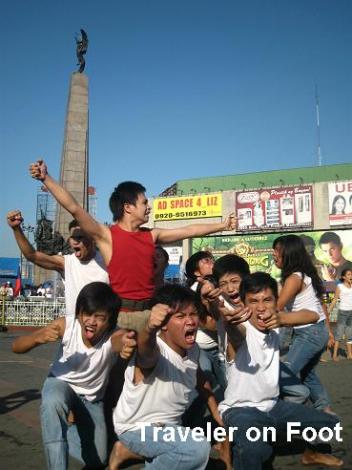
More than a century ago this month, on the morning of May 10, 1897, in hills of Maragondon, Cavite, Andres Bonifacio and his brother Procopio were executed by the Revolutionary Government for the crime of treason. According to historical accounts, Procopio was hacked to death while Andres was shot. Bonifacio was carried uphill on a hammock, being invalid from wounds he suffered when arrested. The brothers were buried where they fell. All this we’ve learned from textbook history. But how well do we know man whose death anniversary we celebrate today?

The Philippines has declared hundreds of historic sites. These sites are marked by a plaque or a representation of our history in murals or sculptures. These representations have successfully created a stereotyped image of our heroes and historic events in our consciousness. Thus, these representations have become a basis of drawings, paintings, sculptures, as well as music, dance interpretations and drama.


According to Ambeth Ocampo, “we actually have two Bonifacio in our consciousness one mythical, the other real and our problem is that myth is more popular than reality.”
Looking back to those days in grade school when we’re asked to watch school play about Bonifacio’s life, I vividly remember the hero was always portrayed by a man wearing an open camisa de chino and pants rolled up to reveal bare feet.

This plebian image of Bonifacio can be seen in Carlos “Botong” Francisco’s mural at Manila City Hall, or in different escayola or cement versions in numerous schoolyards and municipal plazas all over the country. Ocampo has observed that “everything seemingly comes from the same mold or idea.”
He traced the origin of this image to a drawing by Jorge Pineda which was reproduced on the cover of Renacimento Filipino on July 14, 1911. From this drawing came the monument by the Ramon Martinez entitled “Ala-ala ng bayang Pilipino sa mga Bayani ng 96” (Memorial of the Filipino Nation to the Heroes of ’96), which was unveiled on September 23, 1911 in Balintawak (this sculpture now stands on the driveway of Vinzons Hall in U.P. Diliman). This monument became famous as the Bonifacio monument commemorating the Cry of Bonifacio, until such an image was challenge by the late National Artist for Sculpture Guillermo Tolentino.
To ensure authenticity, Tolentino painstakingly researched and interviewed people who had known Andres Bonifacio. He even consulted a espiritista (spirit medium) to discern the true likeness and character of Bonifacio. His efforts resulted into his creation of a masterpiece in bronze in Caloocan. Here Bonifacio is depicted wearing shoes, a buttoned Barong Tagalog and a handkerchief tied on his neck while standing defiantly with a bolo in one and a gun in other. Behind him is Emilio Jacinto and a standard bearer of the Katipunan flag. Over time, this monument has become known as the Monumento.

Tolentino’s sculpture was criticized. He countered his critics with his researched. Tolentino argued that the likeness of Bonifacio was not only based on the hero’s photograph the bone structure of his sister Espiridiona. His interviews of surviving Katipuneros gave an idea of his attire and revealed that, contrary to popular belief, Bonifacio favored his gun over his bolo. One account says that on their way to Caloocan in 1896, many Katipuneros traveled disguised as women to get pass the Spanish police and military (others gave an excuse that the bolo was for the Feast Day of St. Bartolomew in Malabon). To make his baro’t saya more convincing, Bonifacio had to leave his bolo and take his gun instead.
National hero Jose Rizal has left us with numerous photographs. However, we only have one authentic photo of Bonifacio of which its authenticity is also being questioned. In this particular faded studio photograph, Bonifacio is shown wearing a coat. Some people said that the photo was taken on the day of his wedding (though not certain whether if that with his first or second wife, Gregoria de Jesus) thus explaining his attire. Other sources said that he wore that to resemble Rizal (to gain authority) during an assembly in Cavite.

For Ocampo, “with only one extant photograph of Bonifacio, we will never know how her really looked. If we are confused by our Bonifacio stereotype when faced with historical facts, it could only mean that more research and writing need to be done.
Information source: Ambeth Ocampo, Bonifacio’s Bolo